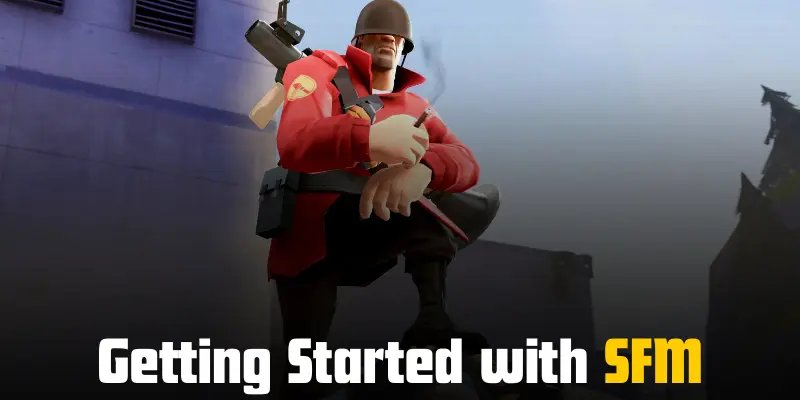Unlock the Power of SFM Compile: Turn Animations into Videos Fast!
Published: 11 Apr 2025
Have you spent hours building an animation in SFM but don’t know how to turn it into a video? You’re not alone. Many beginners get stuck at the compile stage. What does “compiling” even mean in Source Filmmaker? How do you do it without messing up your project? Let’s break it down step by step.
If you enjoy creating animations with game characters or scenes, Source Filmmaker (SFM) is a great tool to start with. It’s a free 3D animation software developed by Valve, mainly used to make short films using assets from games like Team Fortress 2, Half-Life, and others.
In SFM, the word compile means turning your animation project into a real video file. This lets you save it, share it on YouTube, or show it to your friends without needing the SFM software to play it.
Compiling is one of the final and most important steps. Without it, your animation just stays inside SFM as a project file that others can’t view easily.
In this guide, you’ll learn how the sfm compile process works and how to do it step by step. Whether you’re making your first video or fixing common export issues, this simple sfm compile walkthrough will help you get it right.
Getting Started with SFM

Before you can compile your animation, you need to set things up in Source Filmmaker. Here’s how to get started the right way.
Installing Source Filmmaker
Install SFM safely and for free using Steam.
- Go to the Steam website or open the Steam app on your PC.
- Search for “Source Filmmaker” in the store.
- Click Install—it’s completely free.
- Once installed, launch SFM from your Steam Library.
Tip: SFM only works on Windows, so make sure your system meets the basic requirements.
Opening a Project
Start with a simple project to explore how SFM works.
- Click File > Open Session or Create New Session when SFM opens.
- Choose a basic map like “sfm_bigroom” to keep it simple.
- Add a character model—for example, a TF2 Scout.
- Try moving the character a little to make a short animation.
Example: Create a 3-second clip of the Scout waving or walking.
Checking the Timeline and Shots
The timeline is where you organize and animate your scenes.
- The timeline sits at the bottom of your screen in SFM.
- It’s split into tracks like shots, models, cameras, and sound.
- Each shot holds a scene or part of the animation.
- Drag, cut, or move clips on the timeline to edit your animation.
Tip: Right-click on tracks to add keyframes, sounds, or camera cuts.
What to Do Before Compiling
Before you hit the compile button, take a few small steps to make sure your animation looks just the way you want it. These checks can save you time and prevent common mistakes.
Save Your Project
Always save your work so you don’t lose your progress.
- Click File > Save or press Ctrl + S.
- Name your project clearly—for example, scout_wave_v1.
- Save it in a folder where you can find it easily.
- Save often while working, especially before compiling.
Tip: Save multiple versions in case something goes wrong.
Double-Check Your Work
Make sure your animation is complete and everything looks right.
- Play the animation from start to finish in the timeline.
- Check if your character moves smoothly.
- Look at camera angles and make sure they focus on the right spots.
- Check if lighting, effects, or sounds are working properly.
Example: If your character walks off screen too early, now’s the time to fix it.
Set Your Work Camera
Use the correct camera so your final video shows what you see.
- Go to the camera menu and select the “work camera.”
- Avoid using the “editor camera”—it doesn’t show in the final video.
- Check if the camera view matches the scene you want to show.
- Preview the shot to make sure framing and movement are correct.
Tip: Right-click on the camera track in the timeline to switch or adjust cameras.
How to Compile in SFM – Step-by-Step

Now that your animation is ready, it’s time to turn it into a real video. Follow these easy steps to compile your project in SFM.
Step 1: Click File > Export > Movie
Start the compile process by opening the export menu.
- At the top left of your screen, click on File.
- Hover over Export, then click on Movie.
- A new window will pop up called the Export Movie window.
- This is where you’ll set all the final video settings.
Tip: If you don’t see the window, minimize other open panels in SFM.
Step 2: Choose Video Settings
Pick the right settings to match your video quality and computer power.
- Format: Choose AVI for high quality or MP4 for smaller file size.
- AVI = Bigger file, better quality.
- MP4 = Smaller file, easier to upload or share.
- Resolution: Choose 1280×720 (720p) for a clear video that’s not too heavy.
- Works great for YouTube or school projects.
- Frame Rate: Set it to 24 fps (frames per second).
- This is smooth enough for most animations.
Tip: Avoid very high settings on slow computers—it can crash or lag.
Step 3: Select the Folder to Save Your Video
Pick a place to save your video so it’s easy to find later.
- In the export window, click Browse or Output File section.
- Create a folder on your desktop called “SFM Renders.”
- Name your video clearly—for example: scout_wave_final.mp4.
- Click Save after setting the path.
Tip: Don’t use special characters (like / or *) in file names—they can cause errors.
Step 4: Click Export and Wait
Start the compiling and let SFM do the rest.
- After setting everything, click Export Movie or OK.
- SFM will begin rendering your video based on your settings.
- Wait for the process to complete—this might take a few minutes.
- Once it’s done, check your video in the folder you selected.
Note: Rendering time depends on how long and detailed your animation is.
Optional Tip: Fixing Choppy Video
If the video looks slow or glitchy after compiling:
- Try reducing the resolution (go from 1080p to 720p).
- Close background programs like browsers or games.
- Keep your timeline short—test with clips under 10 seconds first.
Common SFM Compile Issues (and How to Fix Them)
Even after following all the steps, you might run into some common problems during the compile process. Here are some issues and their solutions to help you get back on track.
Black Screen After Export
This happens when the camera used during compiling isn’t the one you see in your project.
- Cause: The “editor camera” might be selected, which doesn’t show in the final video.
- Fix: Ensure that the “work camera” is selected before exporting.
- To do this, go to the camera menu and make sure it’s set to work camera.
- Tip: Always preview the scene with the work camera before exporting to avoid this issue.
Example: If you see a black screen after exporting, check your camera settings in SFM.
Video Not Saving
Sometimes your video won’t save or the folder path seems broken.
- Fix: Check that your folder path doesn’t have any special characters like /, ?, or *.
- SFM can’t save videos in folders with these characters.
- Tip: Stick to simple folder names like “SFM Renders” or “My Animations”.
- Fix: If your video still doesn’t save, try selecting a different location or drive.
Example: If your video isn’t appearing, change the folder name to something simple like “C:MyVideosSFM”.
Long Rendering Time
Rendering can take a long time, especially with detailed or lengthy scenes.
- Tip: If the rendering time is too long, try shortening the scene or reducing the video quality.
- Use 720p resolution instead of 1080p.
- Lower the frame rate (e.g., 15 fps) for faster render times.
- Fix: Try rendering smaller parts of your scene first to test settings.
Tip: Rendering long scenes with lots of effects can be slow. Break it into smaller parts if needed.
Extra Tips for Smoother SFM Compiling
Want your SFM compiling process to go more smoothly? Here are some helpful tips to avoid common issues and get better results.
Use Short Scenes First to Test Your Settings
Test smaller scenes before rendering full-length animations.
- Why: Short scenes are quicker to render and let you check your settings.
- Tip: Create a 5-10 second animation to test video settings like resolution, frame rate, and format.
- Benefit: This helps you make sure everything looks good before working on larger, more time-consuming projects.
Example: Test one simple scene before exporting the full animation.
Keep Your PC Cool—Rendering Uses a Lot of Power
Rendering can put a lot of strain on your computer, so keep it cool.
- Why: SFM rendering uses a lot of CPU power, which can overheat your PC if you’re not careful.
- Tip: Make sure your PC has good ventilation and is placed in a cool, open space.
- Fix: Close any unnecessary programs to reduce the load and free up more power for rendering.
Example: If your PC starts slowing down during rendering, try turning on a fan or moving to a cooler area.
Save Different Versions of Your Project in Case Something Breaks
It’s always a good idea to save your work in multiple versions.
- Why: You might run into problems during exporting, and it’s always helpful to have an earlier version to fall back on.
- Tip: After making major changes, click File > Save As and give the project a new name (e.g., animation_v2).
- Benefit: If something breaks, you can quickly go back to a working version and try again.
Example: Name your files like animation_v1, animation_v2, etc., so you can easily identify and return to previous saves.
Conclusion
So guys, in this article, we’ve covered sfm compile in detail. Whether you’re new to SFM or a seasoned animator, following these steps will help you turn your animation into a smooth, professional video. My personal recommendation is to always start with short test scenes before compiling your final project, just to make sure everything looks perfect.
Now that you’re ready to compile, try it out yourself! If you run into any issues, don’t hesitate to refer back to the tips in this guide.
Frequently Asked Questions (FAQs)
Compiling in SFM means converting your animation project into a finished video file. This allows you to save, share, and view your animation without using the SFM software. The process involves selecting video settings and rendering your scene.
This usually happens if the folder name or path contains special characters, like slashes or asterisks. Make sure your file path is simple and contains only letters and numbers. Also, double-check that you’re exporting to a location with write permissions.
AVI is a larger file format that provides better quality, but it can take up more space. MP4 is a smaller, more compressed file format that is easier to share and upload. Choose AVI for quality and MP4 for convenience.
Always use the work camera when compiling, as it shows the scene exactly as it is in your project. The editor camera won’t appear in the final video. You can select the work camera in the camera settings before exporting.
Choppy videos are usually caused by a high resolution or a low frame rate. Try reducing the resolution to 720p and setting the frame rate to 24fps, which is good for most animations. Additionally, closing background apps can help improve performance.
Rendering time depends on the complexity of your animation and your computer’s power. Short and simple animations usually take a few minutes, while longer, more detailed ones may take an hour or more. If rendering is slow, try lowering quality settings or rendering smaller clips.
Yes, you can compile a video without sound if you don’t need audio for your project. Simply leave the audio track empty or remove it before exporting. If you want to add sound later, you can do so in video editing software.
The work camera is the one you use to view and animate your scene. It’s what will show up in your exported video. To select it, click on the camera menu and make sure the work camera is active before you start compiling.

- Be Respectful
- Stay Relevant
- Stay Positive
- True Feedback
- Encourage Discussion
- Avoid Spamming
- No Fake News
- Don't Copy-Paste
- No Personal Attacks

- Be Respectful
- Stay Relevant
- Stay Positive
- True Feedback
- Encourage Discussion
- Avoid Spamming
- No Fake News
- Don't Copy-Paste
- No Personal Attacks



